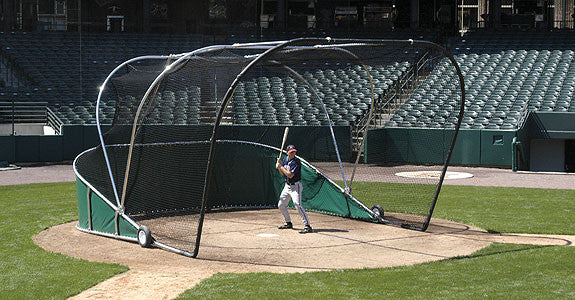Rapid Fire Ground Balls
This is a great way to end your traditional infielders’ positional work during practice. At the conclusion of your normal ground ball work at each position (third to first, short to first, second to first, 6-4-3 double play, 5-4-3 double play, 3-6-3 double play, etc.) have your infielders all gather at their respective positions and prepare them for rapid fire ground balls.
For example, your third baseman will be at his or her usual spot while the coach is hitting a fresh ground ball the split second he/she throws the ball across the diamond. This will make the fielder have a constant head on their shoulders and be prepared for whatever may come next (a ball hit to their left, hit to their right, a slow roller, a high chopper, etc.).
Since the ground balls are coming at a non-traditional rate, this will create a fun and competitive environment for your team and coaches. You’re also likely get some players that begin diving at balls and getting dirty, which will certainly get a rise from their teammates. Just make sure they’re still utilizing proper footwork and mechanics, as this drill can become a little bit chaotic.
This take time and work to get players to learn how but it is a great drill and will pay off with ball handling in the game.
CREDIT TO: thehittingvault.com
In this time of having to stay home bound players are board and on the computer for many hours. But while I advocate for them getting outside and being active there certainly are some activities that they can do on that computer that will improve their mental knowledge of the game and maybe give them insight.
Here's a few that might work for you but please encourage your player and/or yourselves to look the sites using Google or any other search engine and specific questions.
Stay mentally sharp as well as physically getting ready for baseball and softball to start.
======================
http://www.freeonlinebaseballgames.com/
====================
Try this type activity while you are home safe.
Bucket Drill
by Randy Huff
(Darien, CT)
Coach sits on a bucket behind pitchers mound (Honey Hole). He will roll slow rollers to either SS or 2nd base.
The drill is designed to have the middle infielders roll a double play, with each player doing a little hop after they throw the ball to first base, signifying a runner sliding into them.
The coach gets to watch how the play unfolds, like watching how the fielders field the ball, flip or throw to 2nd base and watching the small hop after the ball is released.
The coach can have a lot of fun with the drill by putting the middle infielders on a stop watch to see who can do it the fastest, kids love the drill.
Then move bucket and coach by home plate and have players go to 3rd base. Have a coach on 3rd base as a runner.
Roll ball to the players at 3rd base, make sure they look the runner back before firing ball to 1st base. Then make sure 1st baseman catches ball for out and pops off base to look at home for the play.
If the player forgets to look coach back, have coach score from 3rd. This is all explained with less than 2 outs of course.
When no one around, improve by yourself, one man drills
Parents you need to kind of look at your kids coaches. A lot of coaches are just loud and still have the best of intentions for your players/children. Never allow volume to be equated with bullying, volume usually has little to do with it what you really need to know is what he says to the players and how he treats them then we may be looking at bullying.
This article could help anybody that reads it understand what is meant when bullying is talked about.
Bullying is a growing epidemic in sports. As sports parents, it's critical for you to be prepared to protect your young athletes. If you think this issue won't ever come up in your kids' sports careers, think again. Bully coaches are the number one topic parents write us about at Kids' Sports Psychology.
Have your kids ever had a coach who yelled at, insulted or intimidated them? It's possible they have, but were too embarrassed to tell you. It's important for you to be on the lookout for bully coaches and to take immediate action if you suspect your young athletes are being bullied.
Bully coaches target all kinds of young athletes. They can set their sights on kids who are overweight, small, or who lack confidence, for instance. These coaches also target gifted athletes because they believe their approach will "toughen up" their athletes.
It's important to keep in mind that most volunteer coaches are not trained. Many of them use teaching techniques that their coaches used with them. Some of them don't understand they're acting like bullies. Many coaches will change their behavior if you approach them in an appropriate manner. We've received letters of confession from coaches who say that once they understood how much their words and actions hurt their athletes, they changed their style.
Whether a coach's bullying is intentional or unintentional, your job as sports parents is the same. If your athletes are teased, excluded or otherwise treated badly by coaches, you need to take steps to help keep their confidence intact, stay focused under adversity, and remain in sports.
The bottom line, for you as parents: Be on the lookout for bully coaches and arm yourself with the information you need to take action.
Recruiting Myth
If you are good enough, college coaches will find you
This is an age-old adage that is often heard throughout the recruiting process and is both out-dated and incorrect. These words are often spoken by an older coach who wishes to dismiss any thoughts by the student-athlete or parent that they should market themselves to institutions by sending out their information. The fact is that this statement is true if you are one of the top 100 players in the country, have already received a great deal of accolades by your sophomore year, and most likely already have several scholarship offers in hand. This is simply not true for most college baseball prospects outside of the top 100. The only way they will know about you for sure is if you send them your profile and express your interest in them. Recruiting is now a global process and despite your skills or success in high school, it is extremely easy to be overlooked by college coaches who have thousands of athletes to scout and hundreds of potential venue’s to scout them at. College coaches don’t read your local town paper and they probably don’t attend your games and only the top 1% of high school athletes are truly discovered. Your performance on the field or court will go a long way toward determining whether or not you get a scholarship offer. You need to be getting results that place you near the top of your competition if you want to get noticed. However, there are other factors which will determine whether or not you get an offer including; grades, character, work ethic, coach-ability, etc. Market yourself with truth, determination, follow up, and stay after it.
Tip No.1: Don't Bunt With Two Strikes
This is a tough one when it fails. We have all seen it in youth baseball when the third baseman plays in close anticipating a bunt.
When the strike count gets to two, the coach will yell to the third baseman something like this: "Two strikes on the hitter. Move back so you are even with the base."
When the fielder moves back, depending on the ability of the batter, I love to give him another chance to bunt, given that the defense and opposing coach are sure the batter will not bunt. I have been successful with this and at other times it has failed.
One warning, if you try this. When your batter does fail, you will hear from all the "General Managers" in the bleachers.
More: 4 Biggest Mistakes Baseball Teams Make in Practice
Tip No.2: Catch Everything With Two Hands
I know most coaches and parents will hold me to task on this one. When my players are moving laterally reaching for a fly ball, I just want them to catch the ball any way possible.
I don't want my players thinking they have to catch everything with two hands if some catches are easier one-handed. If the shortstop is sprinting for a pop-up behind the third baseman, and has to reach for it, a one-handed catch works best.
When catching a pop-up hit right to a player, with little or no running, a two-handed catch works best. But too many coaches and parents overemphasize catching everything with two hands. Coaches need to have youth players practice catching balls with one and two hands.
Tip No.3: Don't Make the First or Third Out at Third Base
Tim McCarver won't invite me over to dinner on this one. I send my runner to third most of the time not worrying about how many outs we have.
I have my teams run the bases aggressively. We get thrown out at third and home more than other teams. But we also win more games than we lose.
More: Drill of the Week: Baseball Catching Drill for Kids
In youth baseball, every game has its share of wild pitches and passed balls. From my many years coaching third base I know that we have a great chance getting the runner home on a wild pitch or passed ball.
I hate ending the inning with a player who doesn't score from third base when some aggressive baserunning would have landed him on third and he would have scored.
Tip No.4: Bigger Baseball Gloves are Better
I was guilty of this when my oldest son played Little League. Every year I wanted to get him a bigger glove figuring the larger the glove, the better chance of the ball landing in the pocket. I was 100 percent wrong on this.
I remember going to Yankee Stadium with a close friend who had an "in" on everything and knew a lot of people. We had front row seats and before the game one of the Yankee infielders came over to say hello to my friend.
As they were talking, I could not keep my eyes off the player's glove and was amazed at how small the glove was. It just about outlined his hand.
I then learned that "glove control" is key for fielders. So, smaller rather than bigger gloves are better, especially for infielders, except the first baseman.
More: 5 Ways to Get Noticed at a Sports Camp
Tip No.5: Bat Your Best Hitter Third or Fourth
Years ago I remember in a few All-Star games, Willie Mays batted leadoff. I know the theory is that you get a couple of batters on base and the big guns will drive them in. I don't agree with this all the time.
I found that in youth baseball sometimes there is a large disparity with the talent of the players. Many times teams have one or two excellent players.
In youth baseball I prefer to bat my best hitter first or second. I cannot tell you how many times my team was down by a couple of runs in the last inning with the bottom of my batting order up.
If my best player batted third or fourth, I'd be doing everything I could to get him up but many times games ended up with my best hitter on deck. Now I like to bat my best player first or second. (I know you might think I'm sacrificing some runs but I love the idea of him getting an extra at bat a game.)
Like everything in coaching your talent at the moment will determine your move as the manager or coach. The term "thinking outside the box" has been overused in many instances.
But when coaching, you do want to think outside the box if it will give your players and team an advantage to succeed. Unpopular decisions may be the best decisions at the time you make them.
Marty Schupak
Whether you're throwing out base runners from the confines of Fenway Park or turning a 6-4-3 double play on a local Little League field, throwing is one of the most important, and physically demanding, aspects of baseball
Just as major leaguers can get a dead arm during spring training, younger players also risk injury as they begin throwing regimens in the spring. The Seven Ball Drill below is a great way to increase arm strength and prepare players for the various throws they will make during the season.
Note: Perform the drill's seven separate steps in sequence to ensure proper arm development.
Baseball Arm Strength Drill
Stand shoulder- width apart, with throwing arm placed upwards at a 90- degree angle. While holding elbow with glove, throw ball to partner using just the wrist.
Sit with legs spread and arm in same position as exercise above. This time use the area from the elbow up to throw ball to partner.
Remain sitting and throw ball by rotating hips and turning upper torso. (Focusing on follow- through is not necessary.) Use the glove arm or elbow to direct throw.
Go to one knee. Throw ball by rotating hips and turning upper torso, as in above exercise. This time emphasize follow- through across the raised knee.
Stand with glove arm closest to partner, and feet shoulder- width apart. Repeat the above steps, concentrating on follow- through. This time throw without moving your feet.
Use all the steps above, this time add a crow hop and throw ball to partner. (Crow Hop: A technique in which you hop forward on your front foot during the wind up of your throw.)
Long toss is the last step. Stand approximately 10 feet apart and toss the ball to partner as quickly as you can for one minute. You can even keep track of the number of catches to turn this into a competition. Emphasize a quick release and concentrate on the ball entering and leaving the glove. Note: For infielders, you can turn this last step into a quick toss by reducing the distance.
By following the steps above, players will find it easier to make all the necessary throws in a game, as well as keep their arm healthy throughout an entire season. A good goal to have, no matter the league, when opening day rolls around.
Baseball Fly Ball Exercise
A dynamic drill used for both infielders and outfielders to work on their jumps and reactions while accelerating to fly balls. The fielder starts from the pre-pitch position. He then uses a quick drop step to open his hips. This creates a direct line toward the ball. A line is formed with 3-4 players. The coach will stand approximately 10 feet in front of players with a ball in his hand. The first player faces the coach and on a command, breaks on the run at a 45 degree angle while looking back at the coach. The coach will then throw a ball slightly ahead of the player which leads to a running catch. After the play, the player returns to the end of the line. The next player in line repeats the drill. This drill can be done to the left, to the right, and straight over the head.
Key Teaching Points
Drop step
The first move for an infielder reacting to a fly ball is a quick drop step. This helps create a direct line to the ball. When the ball is hit directly over your head, it is best to drop step to your glove side, which gives you a little longer reach when catching a ball.
Acceleration
Have the player make his first 2-3 steps as quickly as possible and accelerate to the ball. Remind players to run on the balls of their feet. Pre-Pitch Set Up: Both infielders and outfielders always begin each drill from the proper pre-pitch set up. This means a good athletic position, knees flexed, hands in front of chest, and eyes on the ball.
We are a new team and not all that good, how do I create a positive atmosphere and keep the players motivated and enjoying the game as they play.
The biggest deal here is that you don't worry and you make a huge deal out of the score not being important. What is important is each accomplishment is what you celebrate and just like hitting the ball and running or picking it up and throwing. Your letter indicates that your worrying about motivation, when in truth just playing to be all the motivation they need not sure hundred percent what you mean by motivation. But little kids like that normally just love to play, let them play in different positions and set goals that you know they're going to accomplish. Just like this past Sunday we had three goals--- for six out of the 12 players to hit the ball, to make one out in the field, and scored one run and we were able to do that because of the way the league is built - inning consists of three outs, seven runs, or batting through the order when we change. We know that were going to accomplish almost every one of these and this week we will have a little different set of goals, but that's what were you tell them are going to try to do and have fun. Then after the game we will make comment immediately away from the parents. So is just you and the coaches and the players talking to each other about what you got accomplished today and how much fun it was. Make no mistake about it all you're doing is creating organized play with this age group you're not creating baseball players you're creating social skills, fun, and organizational aspects that they will need to work with. But winning and losing is the last thing that needs to be even brought up.
The very first year I coached we were eight year olds in a 10 under league we were 0-44, and the thing they remember to this very day is that we went to Pizza Hut and celebrated a rainout. but by the time they were 12 years old we were 2nd in the BABE RUTH WORLD SERIES for 12 and under.
Let me know what you think and hope that I've created some thought process.
Coach Arnald Swift










